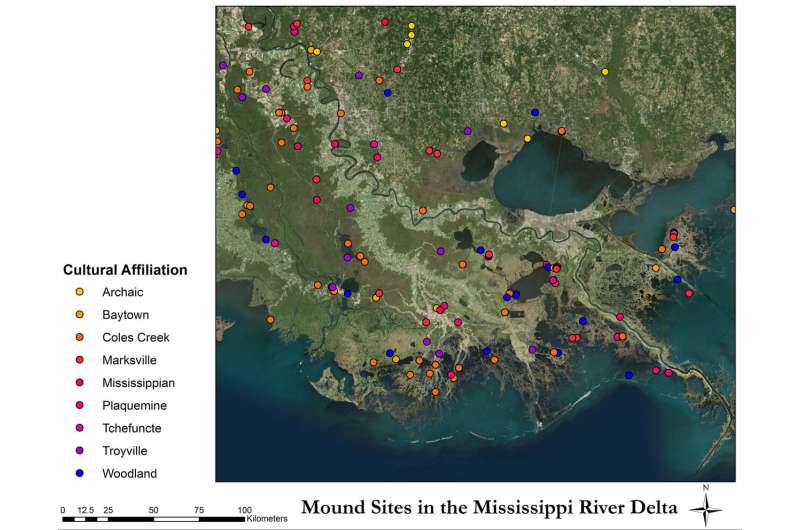This article has been reviewed according to Science X's editorial process and policies. Editors have highlighted the following attributes while ensuring the content's credibility:
fact-checked
trusted source
proofread
Research highlights importance of including Indigenous cultural perspectives in coastal restoration plans

Earthen and shell mounds built hundreds of years ago by Indigenous people in the Mississippi River Delta contribute to biodiversity and the area's resiliency to erosion today, research by a Florida State University archaeologist has found.
As Indigenous communities in what is now Louisiana mined resources from the environment, they created earthen and shell mounds on the marsh grass coasts, which also served as strategic vantage points for surveying the plains.
Today, the river delta's ecosystem and cultural history are endangered by coastal erosion, industry and other land-use practices.
The research, led by Jayur Madhusudan Mehta, an assistant professor in the Department of Anthropology, can help inform coastal restoration practices by orienting restoration efforts toward the entire ecosystem, including archaeological sites. The study is published in the journal Humanities and Social Sciences Communications.
"These archaeological sites are incredibly important landforms. They're places of significance to Indigenous peoples and later historic communities, and if we lose them, we're putting the entire ecosystem at risk," said Mehta, who specializes in the study of North American Native Americans, human-environment relationships, and the consequences of French and Spanish colonization in the Gulf South.
The sites serve as cultural landmarks and bulwarks of the ecosystem. Earthen mounds, shell mounds, shell rings and ridges offer space for more vegetation, which helps the environment resist erosion over time.
These archaeological sites were often built on high elevations, and when constructed several meters higher, they also supported vantage points to improve visibility across the flat landscape.
In recent decades, the Mississippi River Delta has been cut with canals to support the transportation of products like oil and natural gas. This has caused an influx of brackish delta water into these freshwater environments.
Brackish water kills marsh grasses and contributes to loss of land along with erosion, sea level rise and subsidence, or the sinking of land-surface elevation.
"We found rapid deterioration of mound sites over the last half century, and we expect this trend to continue if unaddressed," said Elizabeth Chamberlain, the study's co-author and an assistant professor of archaeology at Wageningen University in the Netherlands. "Immediate efforts are needed to protect and study Louisiana's archaeological sites before they are lost to the sea."
In this study, Mehta and Chamberlain analyzed archaeological sites in the Lafourche subdelta, a small subregion of the Mississippi River Delta.
Using light detection and ranging, or LIDAR mapping, a remote sensing method that employs a pulsed laser to measure land surface elevation, Mehta analyzed the landscape and topography. They also used aerial photography to observe vegetation density.
To best understand the cultural impacts of the archaeological sites, the researchers referenced written records of Indigenous oral histories and state-curated archaeological site archives.
"Our analysis shows that these sites tend to be reused and adopted for different purposes over the centuries," Mehta said. "This points to a persistence of use and meaning of these sites, and we argue that they're keystones not only to Indigenous peoples and later historic communities, but also to the entire ecosystem."
The research also helps inform restoration processes of the larger ecosystem alongside the cultural components of the marshes. Louisiana marshes are full of wildlife, and Indigenous communities have interacted with and changed these ecosystems for thousands of years.
The team hopes their findings will influence management priorities for the changing coast to foster environmental resilience in rapidly shrinking coastal Louisiana.
"When colonists first arrived in Louisiana in the late 1600s, this area was not a pristine wilderness –– it had already been shaped by human hands for thousands of years," Mehta said. "When we think about restoring the ecosystem, we must ask what we are trying to restore back to. It's important to consider the archaeological and cultural impact of Indigenous peoples on these landscapes and do the best that we can to save these places."
More information: Jayur Madhusudan Mehta et al, Cultural-ecosystem resilience is vital yet under-considered in coastal restoration, Humanities and Social Sciences Communications (2023). DOI: 10.1057/s41599-023-01758-z
Provided by Florida State University



















